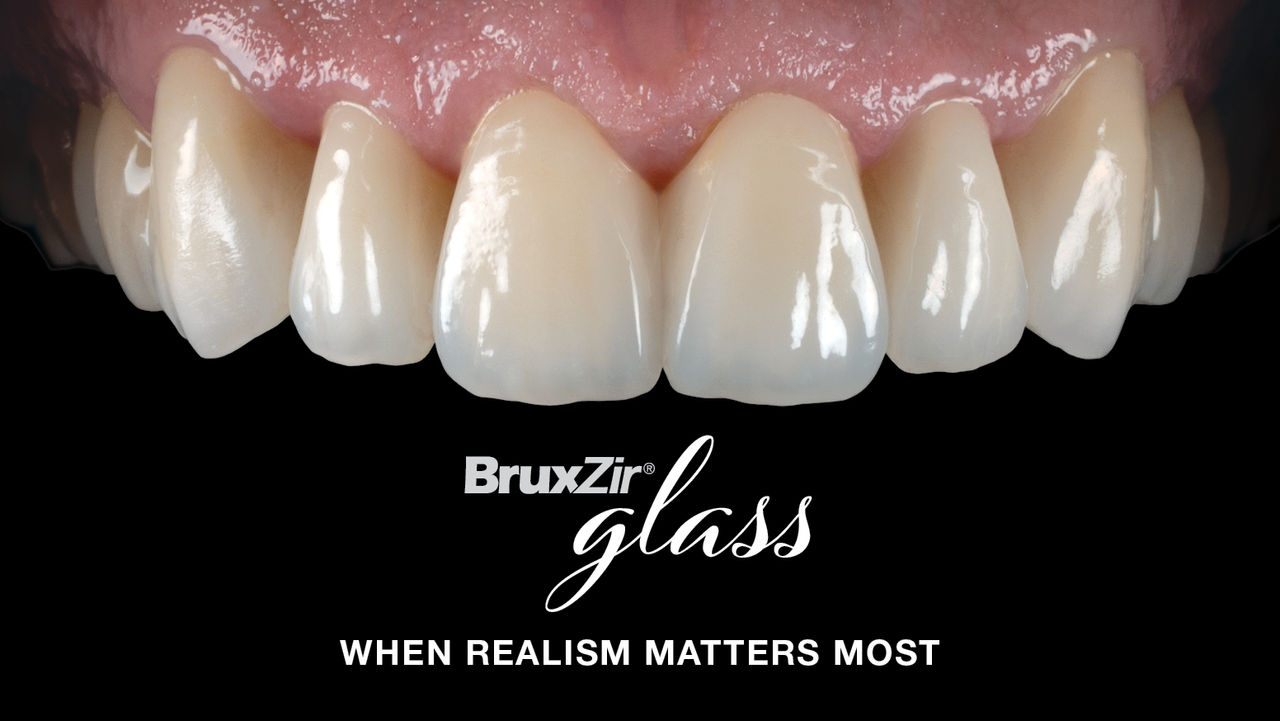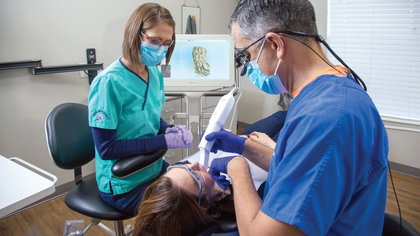2201 Dupont Dr., Irvine, CA 92612
© 2025 Glidewell. All rights reserved.
800-854-7256 USA
BruxZir® Glass combines lithium disilicate and zirconia to create restorations virtually indistinguishable from nature.

Are you a dentist who has been using monolithic restorations to great success, but sometimes find they’re missing that special something that takes your case from good to excellent? Though their appearance is more than adequate for most clinical scenarios, you’re not alone in thinking monolithic restorations can lack the vitality, polychromatic qualities and depth of anatomy found in real teeth. At Glidewell, we felt the same way — that’s why we’re excited to introduce BruxZir® Glass.
BruxZir Glass is a bilayered solution designed to mimic the look of real teeth. It replicates the enamel-over-dentin composition found in nature by pressing lithium disilicate over an anatomically shaped BruxZir Zirconia core. The result of this glass-to-zirconia form factor is a restoration with multilayered anatomy, lifelike coloration and wraparound translucency. In short, an appearance nearly indistinguishable from the real thing.
For dentists and patients who are looking for restorations that look like real teeth, not crowns, BruxZir Glass is the ideal solution.
BruxZir Glass is a restorative solution that’s meant to mimic nature in both form and function. Made by pressing lithium disilicate over zirconia, this bilayered restoration replicates the enamel-to-dentin composition of real teeth.
The inner zirconia core is shaped with mamelons and lobes, while the outer glass veneer is beautiful and translucent. When combined, the effect is a restoration with internal anatomy that hints through the facial surface and wraparound translucency in the incisal and interproximal areas.
Each of the two materials provides a different esthetic purpose, with the inner zirconia providing a deep, warm hue while the outer lithium disilicate allows for substantially more light transmission, and thus a brighter effect.
In essence, BruxZir Glass represents a modern reimagination of the traditional bilayered restoration, such as a PFM. Except with cutting-edge zirconia used in place of metal, and high-performance lithium disilicate in place of feldspathic porcelain. Those two materials transform the old-standby PFM into an advanced ceramic solution.
BruxZir Glass restorations are purpose-driven to create realistic results. This is made possible by the enamel-to-dentin design of the restoration, where lithium disilicate is pressed over zirconia to closely mimic natural anatomy. This bilayered composition creates an effect of multilayered anatomy, varied translucency and multifaceted coloration. Just like a real tooth, the look of BruxZir Glass is purposefully imperfect and nuanced — after all, anything “too perfect” is a dead giveaway that it isn’t natural. BruxZir Glass is a total departure from the flat, white monolithic restorations that have become the standard across the industry. Your esthetically inclined patients will appreciate the depth of realism provided by BruxZir Glass.
The zirconia substructure of every BruxZir Glass restoration serves as more than a strength-providing element. It also serves to mask any underlying colors, such as dark stumps or implant abutments. And because the substructure is made from opaque zirconia and not metal, there’s no risk that the substructure itself will create any unwanted color bleed-through. Just like natural dentin, the zirconia substructure provides the esthetic baseline for the completed crown.
BruxZir Glass is a restorative solution that’s meant to mimic nature in both form and function. Made by pressing lithium disilicate over zirconia, this bilayered restoration replicates the enamel-to-dentin composition of real teeth.
The inner zirconia core is shaped with mamelons and lobes, while the outer glass veneer is beautiful and translucent. When combined, the effect is a restoration with internal anatomy that hints through the facial surface and wraparound translucency in the incisal and interproximal areas.
Each of the two materials provides a different esthetic purpose, with the inner zirconia providing a deep, warm hue while the outer lithium disilicate allows for substantially more light transmission, and thus a brighter effect.
In essence, BruxZir Glass represents a modern reimagination of the traditional bilayered restoration, such as a PFM. Except with cutting-edge zirconia used in place of metal, and high-performance lithium disilicate in place of feldspathic porcelain. Those two materials transform the old-standby PFM into an advanced ceramic solution.
The process of layering one material over another is not revolutionary in dentistry. What distinguishes the BruxZir Glass workflow is that cutting-edge systems, like AI-assisted design and 3D printing, are used in the manufacturing process to great effect, bolstering the level of precision and final look.
After the lab receives your impression, each BruxZir Glass restoration begins as a two-part digital file, with one data set informing the substructure and the other the veneer. Glidewell’s proprietary CrownAI™ auto-generates the complete restoration based on the details of the impression, then a digital design technician can make any further adjustments if needed. During this design phase, special care is taken to ensure that the proposed mamelons and lobes of the inner layer don’t conflict with the ultimate look of the lithium disilicate shell — to appear like real teeth, the internal features should be prominent but not overpowering.
Once the design is confirmed, the substructure is milled from BruxZir Full-Strength Zirconia. Then, the veneer is 3D printed in wax, with the wax form invested and burned away to create a mold. Lithium disilicate is pressed into the mold over the zirconia substructure, forming the two-layered restoration.
Monolithic restorations have become the standard solution for general dentistry over the last two decades. They’ve demonstrated proven excellence for most clinical scenarios, especially cases where durability is the priority. But, as a result of their single-material composition, they can end up looking flat — from mesial to distal, there’s no visual variation.

For scenarios that demand the most lifelike esthetics, BruxZir Glass provides a look that’s nearly indistinguishable from real teeth. Its bilayered construction mimics the enamel-to-dentin form found in nature, with an internal zirconia layer featuring mamelons and lobes and the outer lithium disilicate layer including surface characterizations, like perikymata. Moreover, the translucency of the veneer means that the internal anatomy can hint through the surface, creating an effect of variable coloration and light transmission.
Where monolithic restorations prioritize strength, BruxZir Glass prioritizes appearance. Still, BruxZir Glass restorations are substantially stronger and more durable than the bilayered solutions of the past, with the BruxZir core boasting more than 1,000 MPa of flexural strength and the lithium disilicate veneer more than 400 MPa.
Compared to the PFMs and the other porcelain-based bilayered restorations of the past, BruxZir Glass is much more durable. In fact, the lithium disilicate veneering layer of BruxZir Glass offers far greater strength than the feldspathic porcelains used throughout dentistry.
For the clinician, this added strength translates to a greatly reduced risk of chipping and cracking. BruxZir Glass provides more than enough strength to meet today’s standards for clinical performance.
In addition to the numerous other validation tests, Glidewell’s Research & Development team conducted the signature ‘Hammer Test’ for BruxZir Glass, demonstrating the impressive strength of the new solution.
As outlined above, BruxZir Glass delivers a natural appearance and outstanding performance. Plus, every BruxZir Glass restoration is backed by the BruxZir Lifetime Warranty. Should anything happen to your case, Glidewell will replace it for free.
If you want your restorative makeovers to look like a natural smile, BruxZir Glass is the “perfect” solution. To start your case, visit the BruxZir Glass promo page. Working with Glidewell is simple, and we’re pleased to accept digital impressions and physical impressions.
Send blog-related questions and suggestions to hello@glidewell.com.

.jpg/_jcr_content/renditions/thumb-jpeg-mobile-full.jpeg)
